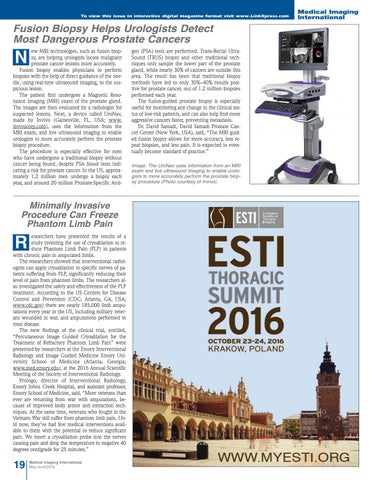To view this issue in interactive digital magazine format visit www.LinkXpress.com
Fusion Biopsy Helps Urologists Detect Most Dangerous Prostate Cancers ew MRI technologies, such as fusion biopsy, are helping urologists locate malignant prostate cancer lesions more accurately. Fusion biopsy enables physicians to perform biopsies with the help of direct guidance of the needle, using real-time ultrasound imaging, to the suspicious lesion. The patient first undergoes a Magnetic Resonance Imaging (MRI) exam of the prostate gland. The images are then evaluated by a radiologist for suspected lesions. Next, a device called UroNav, made by Invivo (Gainesville, FL, USA; www. invivocorp.com), uses the information from the MRI exam, and live ultrasound imaging to enable urologists to more accurately perform the prostate biopsy procedure. The procedure is especially effective for men who have undergone a traditional biopsy without cancer being found, despite PSA blood tests indicating a risk for prostate cancer. In the US, approximately 1.2 million men undergo a biopsy each year, and around 20 million Prostate-Specific Anti-
N
Minimally Invasive Procedure Can Freeze Phantom Limb Pain esearchers have presented the results of a study investing the use of cryoablation to reduce Phantom Limb Pain (PLP) in patients with chronic pain in amputated limbs. The researchers showed that interventional radiologists can apply cryoablation to specific nerves of patients suffering from PLP, significantly reducing their level of pain from phantom limbs. The researchers also investigated the safety and effectiveness of the PLP treatment. According to the US Centers for Disease Control and Prevention (CDC; Atlanta, GA, USA; www.cdc.gov) there are nearly 185,000 limb amputations every year in the US, including military veterans wounded in war, and amputations performed to treat disease. The new findings of the clinical trial, entitled, “Percutaneous Image Guided Cryoablation for the Treatment of Refractory Phantom Limb Pain” were presented by researchers at the Emory Interventional Radiology and Image Guided Medicine Emory University School of Medicine (Atlanta, Georgia; www.med.emory.edu), at the 2016 Annual Scientific Meeting of the Society of Interventional Radiology. Prologo, director of Interventional Radiology, Emory Johns Creek Hospital, and assistant professor, Emory School of Medicine, said, “More veterans than ever are returning from war with amputations, because of improved body armor and extraction techniques. At the same time, veterans who fought in the Vietnam War still suffer from phantom limb pain. Until now, they’ve had few medical interventions available to them with the potential to reduce significant pain. We insert a cryoablation probe into the nerves causing pain and drop the temperature to negative 40 degrees centigrade for 25 minutes.”
R
19
Medical Imaging International May-June/2016
gen (PSA) tests are performed. Trans-Rectal UltraSound (TRUS) biopsy and other traditional techniques only sample the lower part of the prostate gland, while nearly 30% of cancers are outside this area. The result has been that traditional biopsy methods have led to only 30%–40% results positive for prostate cancer, out of 1.2 million biopsies performed each year. The fusion-guided prostate biopsy is especially useful for monitoring any change in the clinical status of low-risk patients, and can also help find more aggressive cancers faster, preventing metastasis. Dr. David Samadi, David Samadi Prostate Cancer Center (New York, USA), said, “The MRI guided fusion biopsy allows for more accuracy, less repeat biopsies, and less pain. It is expected to eventually become standard of practice.” Image: The UroNav uses information from an MRI exam and live ultrasound imaging to enable urologists to more accurately perform the prostate biopsy procedure (Photo courtesy of Invivo).
Medical Imaging International
